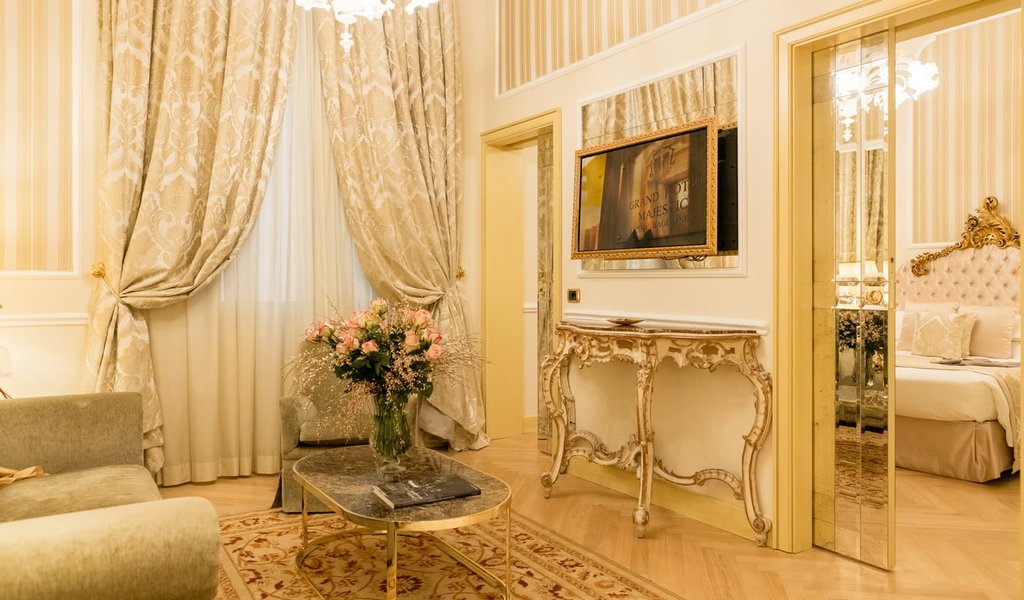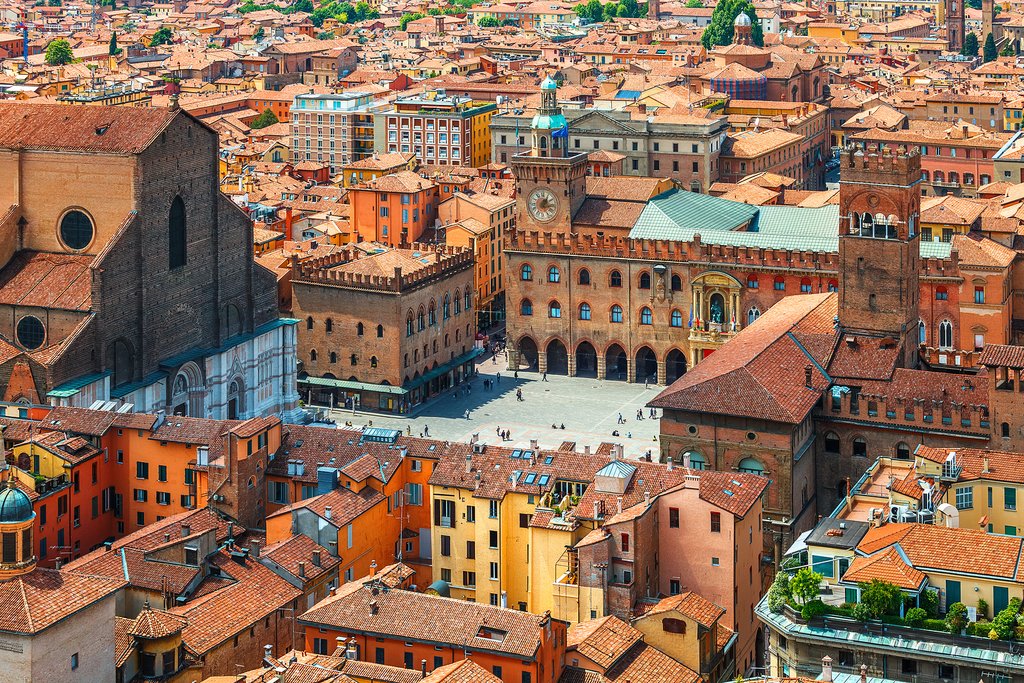Discover Bologna
Though it only attracts a fraction of the Rome-Florence-Venice tourist trade, Bologna is an enchanting city of soaring redbrick towers and stately colonnades (almost 25 miles of grand porticos cover the sidewalks). Its well-preserved historic center, all pink and terracotta, is one of the largest in Italy, but this no museum: Bologna is a dynamic, working metropolis of one million inhabitants, one of the richest in the country.
Planning Your Trip

It is possible to get a taster of Bologna in one day, though two or three days will allow a more thorough exploration (and more importantly, more time to eat). If you only have 24 hours here, start with an espresso at the Piazza Maggiore before admiring San Petronio church. Make sure you stroll the narrow alleys of the Quadricentro before climbing the Asinelli, one of the city’s leaning Due Torri.
Grab a tasty, cheap lunch at the city market, the Mercato delle Erbe, before spending an afternoon amidst the old masters in the Pinacoteca Nazionale, or taking in some of Bologna’s great churches such as Basilica di San Domenico. Be sure to save some energy for a gourmet dinner and the city’s frenetic nightlife.
With a few more days at your disposal, you can truly get under the skin of Bologna, wandering the ancient university and its museums, taking in the more contemporary art at MAMbo and the city's history at the Museo della Storia. Check out more itinerary ideas for Italy here.
When to Go
Bologna is easily accessible year-round. There really isn’t a tourist “high season,” though March to June and September to October are the best months weather-wise. July and August can be very hot. What really affects hotel rates are trade fairs and conferences – Bologna hosts four to six major trade fairs a year, during which hotel room rates rise dramatically, so it pays to check the latest schedule before visiting. For more general info, read on about the Best Time of Year to Visit Italy.
Getting There and Around
Bologna is linked to numerous cities within Europe by air, Guglielmo Marconi Airport served by national carriers and low-cost airlines such as Blu-express, easyJet, Wizz Air and Ryanair. North American travelers can fly non-stop, but only in the summer (American from Philadelphia). High-speed trains from Rome, Milan, Florence, and all over Italy arrive at Bologna’s Stazione Centrale in the center of the city.
With most of the major sights in and around Piazza Maggiore, central Bologna is easy to explore on foot. City buses are cheap (1.30 Euros or 5 Euros for 24hr) and depart for most points from Piazza Maggiore, and the train station. Taxis are relatively pricey (the meter starts at 4 Euros), and you’ll normally have to phone them to get a ride.
Bologna passes
The digital Bologna Welcome Card is a tourist discount scheme: for 25 Euros you get free entry to most of the museums in the city (and various discounts in shops and restaurants) – it’s valid for one year (one use per site). The similarly virtual Card Musei Metropolitani Bologna is also 25 Euros, and covers even more (30 museums with free admission, 26 with reduced admission), also for one year. You can compare the cards on-line, but you’ll only save money if you visit almost every museum listed.
Chat with a local specialist who can help organize your trip.
Highlights & Activities

At the heart of Bologna lies the monumental space of Piazza Maggiore, the best place to start any visit – most of the city’s top sights are within an easy walk from here. On the piazza itself lies the ornate Palazzo D’Accursio (or Palazzo Comunale), which served as the Bologna city hall till 2008. Inside are a labyrinth of frescoed halls and chapels, plus the Municipal Art Collections and the world’s oldest Torah.
The adjacent Piazza Nettuno contains the Fontana di Nettuno (Neptune Fountain), a symbol of the city, although it was designed in 1566 by a Flemish sculptor named Giambologna (the locals gave him an Italian name) and was viewed as “indecent” by the Catholic Church – take a closer look to work out why.
Basilica di San Petronio and around
Looming over Piazza Maggiore, this enormous church honors the patron saint of Bologna (aka St. Petronius), bishop of the city from 431 to 450 (his remains were reinterred here in 2000). Inside, the lavish Cappella Bolognini is embellished with frescoes by Giovanni da Modena. The nearby Museo Civico Archeologico boasts one of Italy’s major Ancient Egyptian collections, as well as precious Etruscan relics dug up in Emilia.
Next door, the Palazzo dell’Archiginnasio served as the home of Bologna University from 1563 to 1803. Inside, the beautiful cedar wood Teatro Anatomico is where dissections of dead bodies were held in the name of medical science. One block east lies the Museo della Storia di Bologna in the Palazzo Pepoli, a contemporary multimedia showcase for the history of Bologna, from Etruscan to modern times.
Basilica di San Domenico
This grand medieval church is home to the beautifully crafted tomb of St. Dominic, founder of the Dominican order. He rests in a chapel designed by the 13th century’s greatest sculptor, Nicola Pisano, smothered in frescoes by Guido Reni and other Bolognese painters from the early 1600s.
Due Torri
Just to the east of the Piazza Maggiore rise the Due Torri, Bologna’s iconic leaning towers, built in the 12th century. The smaller one, the Garisenda, is only 162ft tall, but it sways tipsily to the south. The taller one, the Asinelli (334ft) is open to the public – climb nearly 500 steps for a panoramic view over the red-tile rooftops of the city.
The Quadrilatero
The warren of medieval lanes behind Piazza Maggiore is dubbed the Quadrilatero, crammed with the city's most celebrated gourmet food shops. La Baita (Vecchia Malga) has offered a phenomenal selection of hams and cheeses since 1969, while AF Tamburini sells salsicce (sausages), prosciutti and mortadella in a shop that’s been here since the 1860s.
Paolo Atti & Figli is THE place for pasta, an institution since 1900, while Salumeria Simoni is a one-stop shop for local produce, especially the Parma hams hanging from the ceiling. Bologna’s outpost of global food hall Eataly sells the usual high-quality Italian foods and wines, while the Mercato di Mezzo opposite is a covered market housing small bars and food stands.
More amazing churches
Bologna's captivating Basilica di Santo Stefano is actually a Romanesque complex of seven small churches, chapels and cloisters. A church has stood on this site since the 5th century, converted from a much older Roman Temple of Isis. San Giacomo Maggiore is another treasure-filled Romanesque beauty built by the Augustinians. Inside, Cappella Bentivoglio is a monument to the 15th-century rulers of Bologna, adorned with faded frescoes by Lorenzo Costa.
Pinacoteca Nazionale di Bologna
Showcase for the most significant works of Emilian and Bolognese painting from the 14th century to the heyday of the baroque – by Jacopo di Paolo, Lorenzo Costa, the Carraci brothers, Guido Reni and many others. The adjacent university campus contains Musei di Palazzo Poggi, home to a veritable 18th-century cabinet of curiosities, including mildly ghoulish anatomical waxwork models.
Manifattura della Arti
The “Factory of the Arts” is an area of former warehouses and factories turned art district, a 15-minute walk from the heart of Bologna. At its core is the Museo d’Arte Moderna di Bologna (MAMbo), which displays its permanent collection of post–World War II Italian art, but is also home (for now) to the superb collection of works by Bolognese artist Giorgio Morandi, aka the Museo Morandi.
Where to Stay

As always, renting an apartment could save you a lot of money (especially for groups or long-stays) – websites such as homeaway.com and airbnb.com are a good place to start. For a splurge, it’s hard to beat the Grand Hotel Majestic, just off the main square, an 18th-century palazzo with frescoes in the restaurant painted by the Carracci brothers. Budget travelers might consider Bed & Breakfast Alberta D, a cozy home in a former medieval hospital with super-friendly hosts, or the slightly more upmarket Antica Residenza d’Azeglio, just five minutes walk from the center. Albergo delle Drapperie is a no-frills B&B with a killer location, just off Piazza Maggiore.
Where to Eat

Many Italians consider Emilia-Romagna–and Bologna specifically–the gastronomic center of the entire nation. Traditional dishes like tortelloni, tagliatelle al ragù and passatelli, not to mention Bolognese sauce, have spread across the world. If you order “spaghetti Bolognese” expect pained looks from your waiter–the sauce (typically just called ragù) is served here exclusively with tagliatelle.
At the top end, long-revered Bitone opened in 1834, the best place to splurge on an expensive dinner. Osteria Satyricon is another exceptional dining experience. For more rustic options, try the venerable Da Cesari, or Drogheria della Rosa, known for its homemade pastas. A bit further out, All’ Osteria Bottega is lauded for its simple, tasty local cuisine. To save money, explore Bologna’s central food market, Mercato delle Erbe, featuring the usual produce and fish vendors but also snack stalls and dining areas. For no-frills tavern-like eats, nothing beats Osteria dell’Orsa – the best ragù alla bolognese in town.
Bologna by Night

Thanks in part to a huge population of students, Bologna has a vibrant, diverse nightlife. Aperitivo, where a glass of wine and as many snacks as you like costs just a handful of Euros in local cafes and bars, usually starts around 6pm. Camera a Sud is a hip student hangout in the old Jewish quarter, while Café de Paris attracts a young crowd with its sleek, modern white couches and elegant interior.
The tastiest dry martinis in Bologna are served at Nu Lounge Bar, while Cantina Bentivoglio hosts the best live jazz. Bologna’s oldest bar is Osteria de Poeti, in operation since around 1600 – with the live music and the requisite brick-vaulted ceilings, stone walls, and ancient wine barrels. Bologna also boasts a lively club scene. Locations often change, but Numa Club and Qubò are good places to start.
